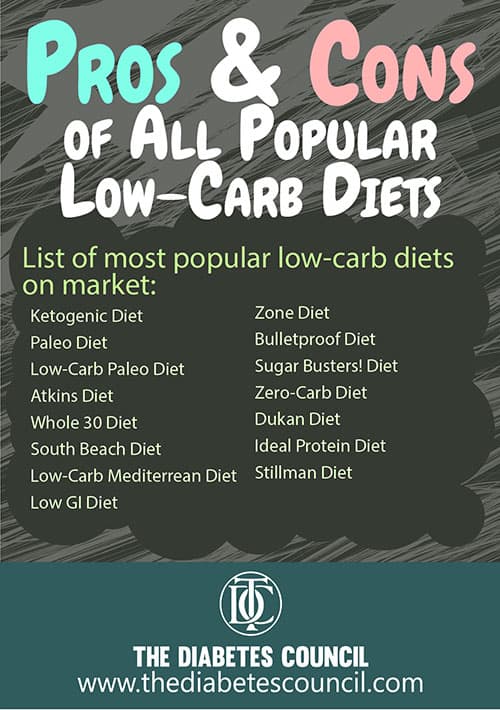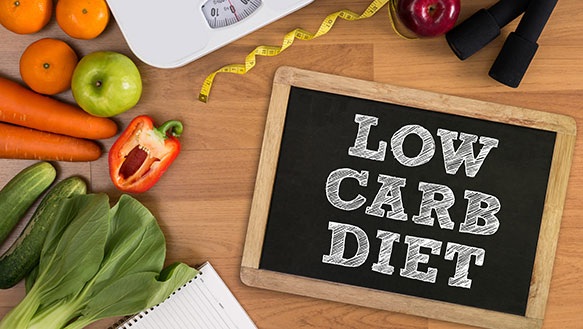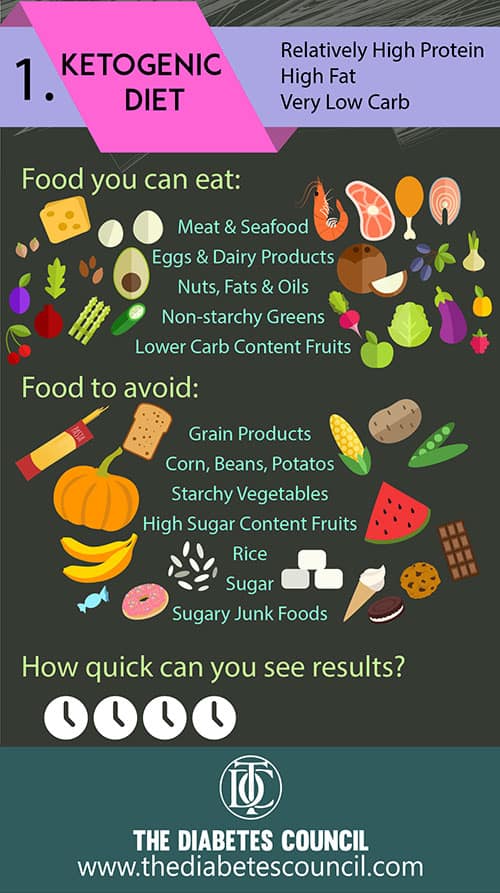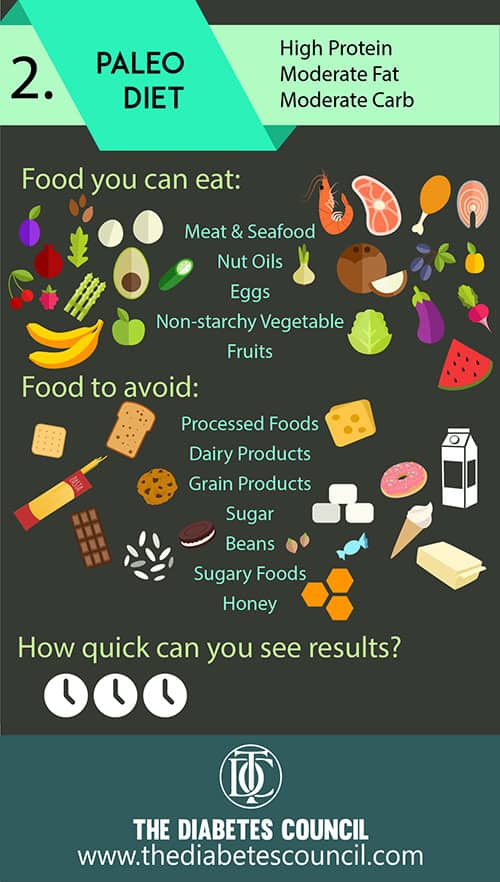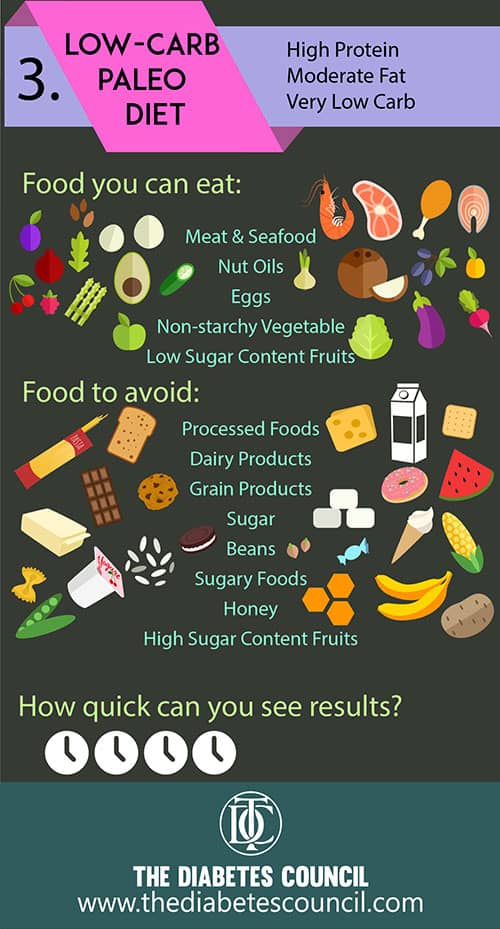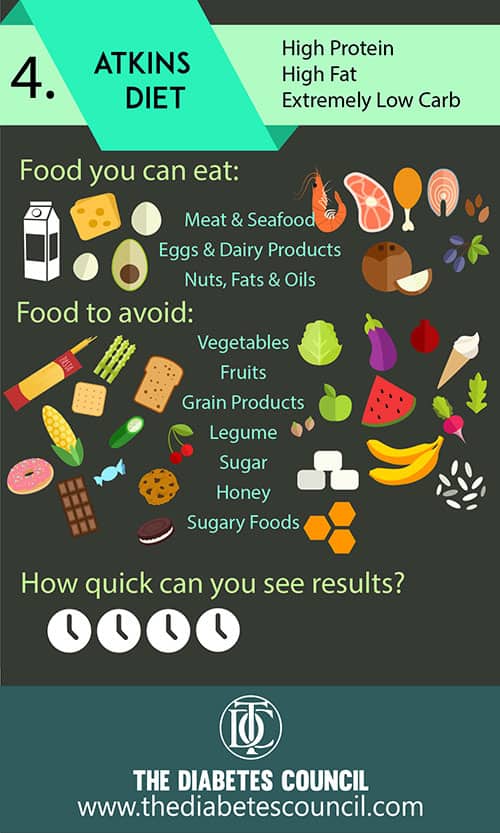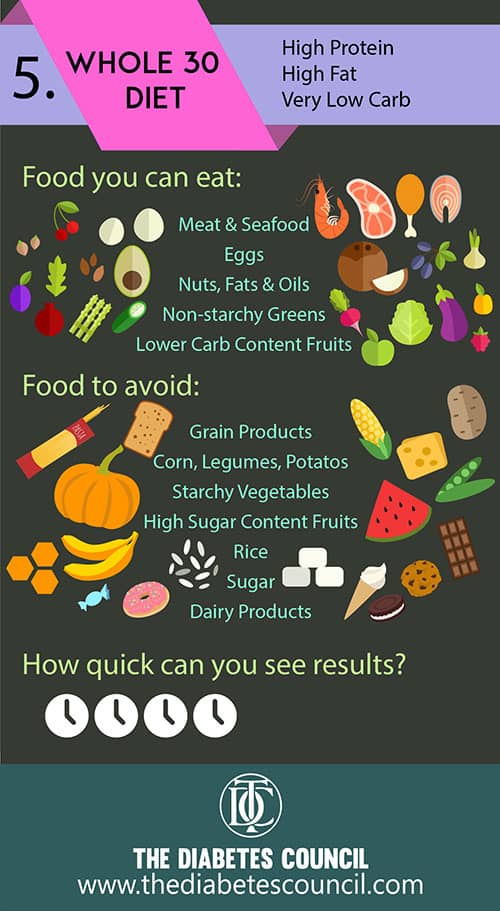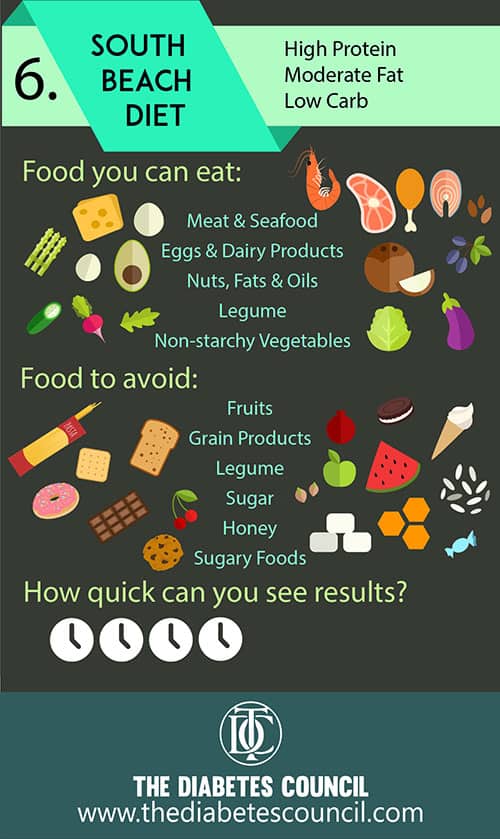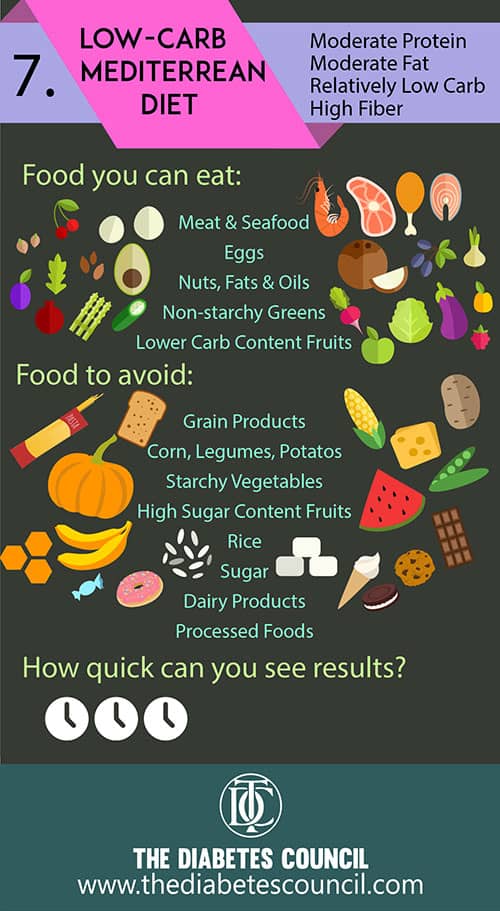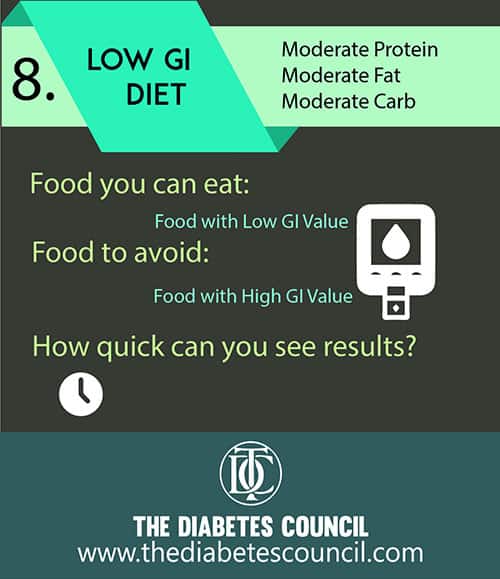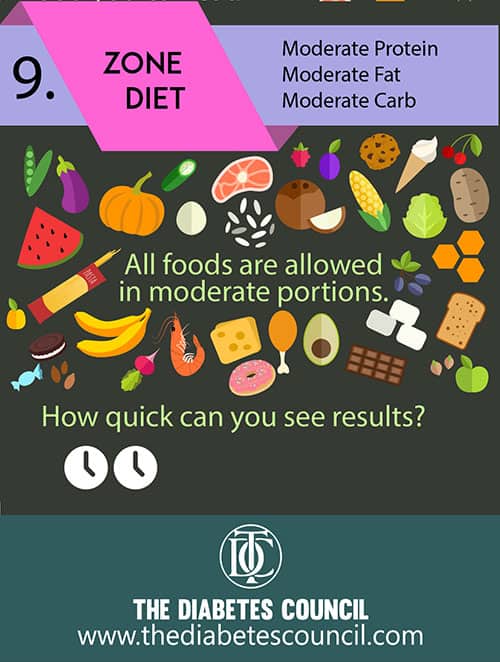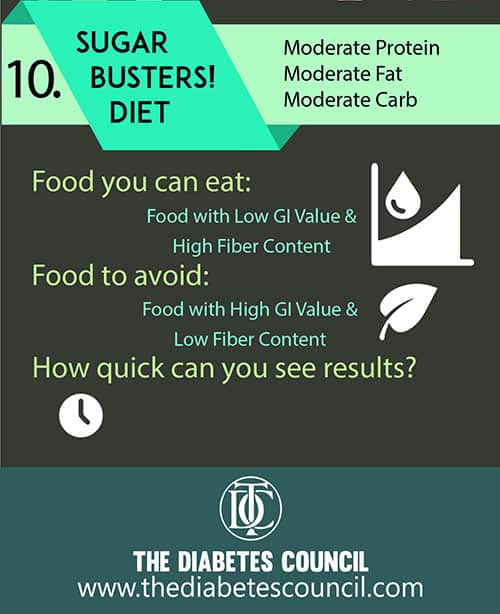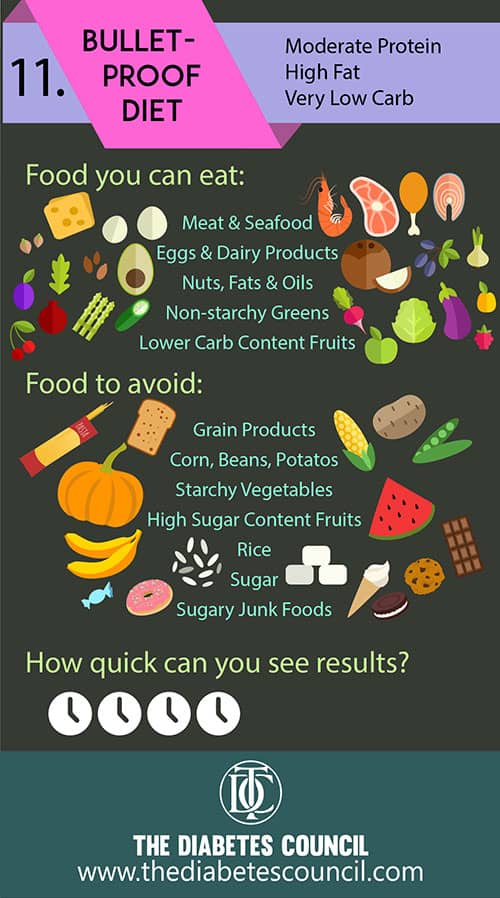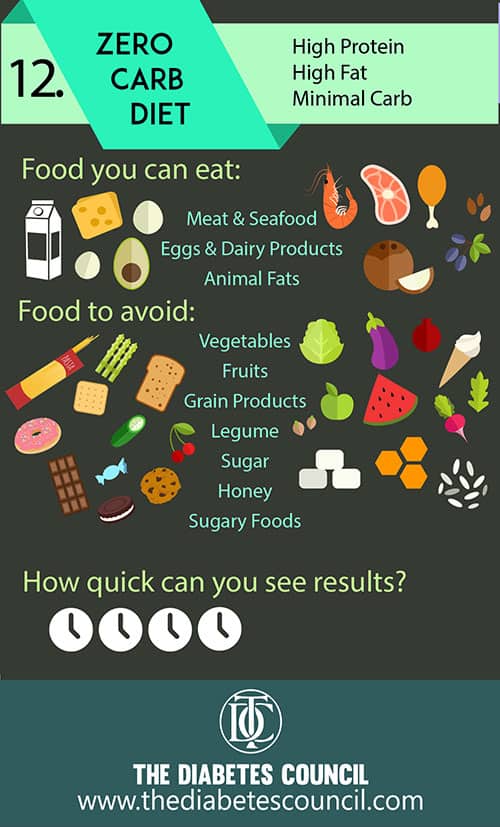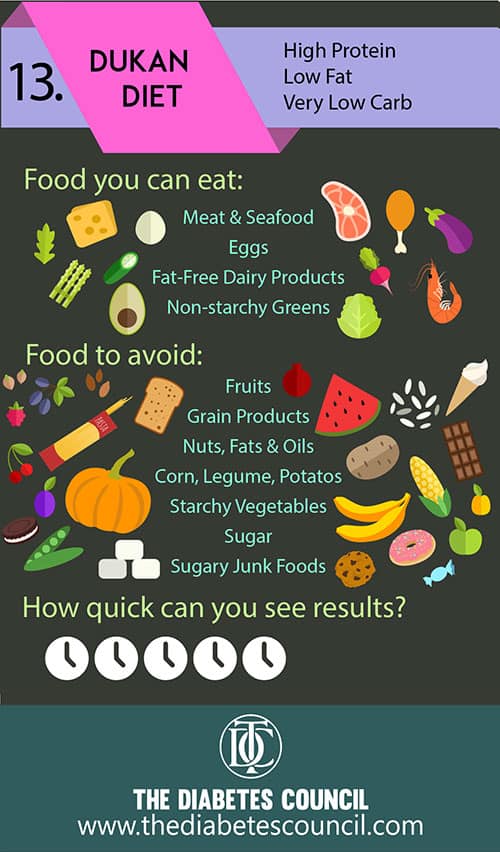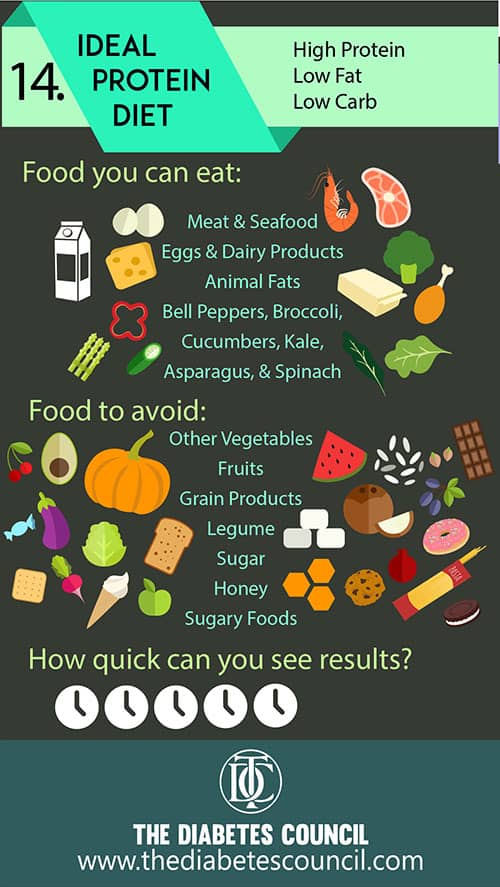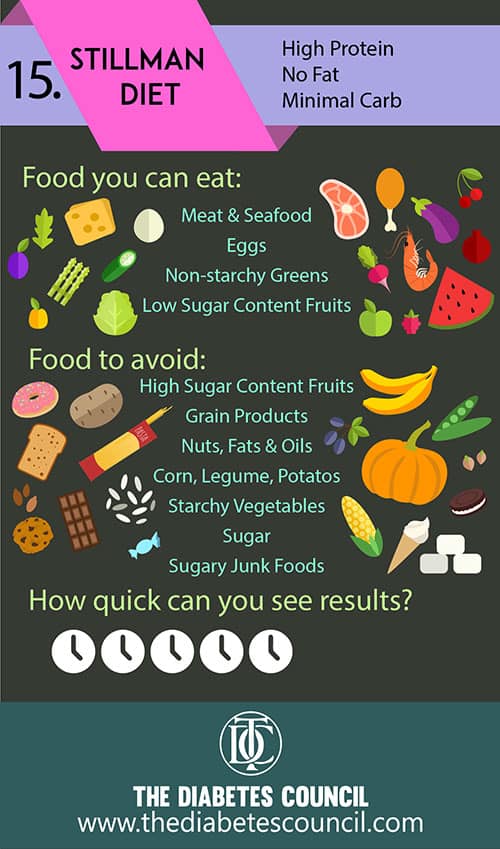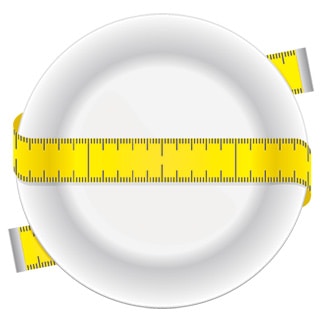Contents
Low-carb diet is one of the latest health trend that promises quick results and maximum health benefits. Many dietitians are recommending low carb diets these days.
But how much of these promises are true?
And are they truly safe for everyone to follow? This article will take a look at the definition of low-carb diet and introduce the pros and cons of each of the low-carb diets listed below:
Quick Links
- Introduction
- What is Low-Carb Diet?
- Carb – The Deciding Factor
- Other Limiting Factors
- Who Should Not Go On A Strict Low-Carb Diet?
- Ketogenic Diet
- Paleo Diet
- Low-Carb Paleo Diet
- Atkins Diet
- Eco-Atkins Diet
- Whole 30 Diet
- South Beach Diet
- Low-Carb Mediterranean Diet
- Low GI Diet
- Zone Diet
- Sugar Busters! Diet
- Bulletproof Diet
- Zero-Carb Diet
- Dukan Diet
- Ideal Protein Diet
- Stillman Diet
- Specific Carbohydrate Diet (SCD)
- Checklist to Consider Before Selecting a Low-Carb Diet Plan
What is Low-Carb Diet?
By definition, low-carb diets are any diet regimens that encourage low consumption of carbohydrates. Over the years, a wealth of health research studies have shown that consuming less carbohydrates have a positive effect on weight loss and health.
As of current, there are so many variety of low-carb diets introduced to the public. Nevertheless, how are they different from each other? In general, they mainly differ by the degree of carbohydrate consumption restriction. For example, certain low-carb diets recommend cutting down on non-healthy high carb food such as sugary drinks, sweet junk foods, pastries, breads, white rice, and pasta. More restrictive low-carb diets even recommend limiting consumption of certain vegetables, fruits, and legume sources. In addition, in extreme cases, very limited amount of vegetables and fruits are allowed in the regime.
The amount of carb intake is also a determining factor. According to the dietary guidelines, carbs should provide approximately 45% to 65% of a person’s total daily calories intake. The most relaxed form of low-carb diets often go with 45% of daily carb calories intake. For the least lenient low-carb diet, the daily carb calories intake may go as low as 10%.
Aside from carbohydrate restriction, another main difference among all the diets is calories constraint. On one end of the spectrum, some diets do not have any rules about calories intake. Those who follow that type of regime are allowed to eat as much calories they like. And on the other end of the spectrum, a very restricted amount of daily calories is allowed.
Who Should Not Go On A Strict Low-Carb Diet?
Most healthy individuals can go on a relatively lenient low-carb diet. As for a strict low-carb diet that involves consuming very little amount of carbohydrate, they are unsuitable for individuals who:
- Suffer from liver and/or kidney disease
- Have a family history of liver and/or kidney issues
- Wish to conceive in the near future
- Are currently pregnant or breastfeeding
- Have certain medical condition that makes them prone to ketosis
- Have a tendency to have low blood glucose level
- Suffer from certain metabolism disease
- Suffer from severe high blood pressure
- Are taking certain medication that affects blood glucose level and/or ketone level
Even if you are healthy and do not fit under any of the previous mentioned circumstances, it is best to consult with your family physician and perform a body check before beginning your diet regime.
For more information about the dangers of a strict low-carb diet, please read this article: Major Side Effects of Cutting out Carbohydrates
I recommend reading the following articles:
- Must Have Kitchen Items: 101 Items Every Healthy Kitchen Needs
- Menopause and Diabetes: Does Menopause Cause Diabetes?
- How Can Weight Loss Be An Important Sign Of Diabetes?
- Ultimate Hiking Guide for People with Diabetes
- If I Have Diabetes, Will I Have to Stop Eating Sugar?
- Link Between Sleep & Diabetes: Everything You Need To Know
Ketogenic Diet
Ketogenic diets are often referred to as keto diets. The objective of a ketogenic diet is to keep carbohydrate intake to a minimum level so that the body kicks into a metabolic state called ketosis where stored fat is metabolized into ketones and used as main source of energy.
There are 4 types of ketogenic diets:
- Standard ketogenic diet (SKD): This type of keto diet includes low intake of carb, and high intake of protein and fat. The typical daily calories intake from these three food groups is 5% carbs, 20% proteins, and 75% fat.
- Targeted ketogenic diet (TKD): This type of keto diet includes low intake of carb, high intake of protein and fat. It also includes small amount of carb consumption before or after workouts to boost metabolism.
- Cyclical Ketogenic diet (CKD): This type of keto diet cycles between low intake of carbs and high intake of carbs. Throughout a week, 5 or 6 days will include low intake of carb, high intake of protein and fat. For the remainder 1 or 2 days, the nutrient intake is switched to a high carb diet. This method is to trick the body to keep the metabolism up and avoid plateauing in the weight loss process.
- High Protein Ketogenic Diet: This regime is very similar to the standard ketogenic diet. The only difference is that higher amount of protein and lower amount of fat are consumed. The recommended ratio is around 5% carbs, 35% protein, and 60% fat.
Pros:
Keto diets have shown to be extremely beneficial for treating certain diseases and disorders such as epilepsy, bipolar disorder, diabetes, and Alzheimer’s disease. Many people who follow this diet can quickly see the change in their physical appearance and their weight drop. And aside from carbs, individuals are allowed to consume a great variety of foods especially meat and fat.
Cons:
The diet rules can be extremely unforgiving. For individuals who follow a vegetarian or vegan lifestyle, it can be a challenge to find protein and fat sources that do not come from animal resources. Even then, there is still the issue whether the plant protein and fat source can provide all the daily nutrient requirements.
Second, the regime is not suitable for everyone. People who have a family history or medical history of cardiovascular diseases, liver and/or kidney problems can do more harm to their bodies by following this way of eating. Also, women who wish to conceive or already pregnant can do a lot of damage to baby by severely limiting their carb intake.
Third, before you can reap in the benefits, you may have to deal with the early “side-effect” symptoms of lowering your carb intake and training your body to utilize ketones as main energy source. Some of the common symptoms you may experience are:
- Fatigue
- Brain fog
- Bad breath
- Mood swing
- Dehydration
- Headache
Once your body adapts to your new way of eating, these symptoms will gradually fade off.
Paleo Diet
Paleo means that you are following the ways of how cavemen used to eat. As a result, no processed food is allowed in the diet. That includes butter, margarine, dairy products, sugar (including all sugar substitute), cereal grains, salty foods, preserved foods, and honey. Instead, the food stable consists of lean protein, non-starchy vegetables, fruits, nuts, seeds, and plant-based oil such as coconut oil, olive oil, grapeseed oil, and walnut oil.
Pros:
This is a great diet plan for anyone who wishes to healthier food that is lower in unhealthy fats and sodium content. It is also an excellent way to cut out preservatives, chemicals, and additives from your diet.
Cons:
There is always the doubt whether cavemen had long lives as there is no scientific evidence behind this theory. At the same time, even though legumes are not processed foods, the paleo diet suggests avoiding this food group as they are less available to Paleolithic humans and not easy to digest. Although there are less strict versions of paleo diet, limiting legumes can increase risk of nutrient deficiency. Contrary to this theory, legumes are packed with many nutrients that can rival meat protein sources.
The paleo diet is not friendly to vegetarians and vegans. Aside from legumes, soymilk, tofu, tempeh, edamame, hummus, and any type of food containing beans are excluded from the edible list. Even if you take a lot of vitamins and supplements to sustain your nutrient intake, you will not be taking in enough protein source to fuel your body.
Even if you can find the raw food sources, you can run into budget problems as these ingredients can be costly.
Low-Carb Paleo Diet
This is one of the most popular low-carb diets as it encourages individuals to consume foods that have not been processed and most likely to be available during the Paleolithic era such as shellfish, meats, eggs, vegetables, fruits, nuts, seeds, and legumes. In stricter variations, grains, dairy products, and various flours are eliminated from the allowed food list.
Pros:
This is truly a great way to get rid of processed foods from your diet and promote eating fresh foods that are high in natural nutrient contents. You can also say good-bye to all the harmful added chemicals from canned goods, food packaging lining, such as BPA chemical from plastic containers.
Cons:
It takes a lot of commitment to not only change your eating habits but also your lifestyle. It takes a lot of planning and preparation if you do not want to eat the same foods repeatedly. In addition, it can be quite unfriendly to the people with busy life schedule and very limited budget.
Atkins Diet
You probably heard about this high protein, high fat, and low cart diet plan in recent years on various social media platforms. Contrary to the common belief that this diet is all about eliminating all carbs and eating only meat, the program is actually split into 4 stages:
- Phase 1 – Induction (Last for 2 weeks): Limit daily carb consumption to less than 20 grams.
- Phase 2 -- Balancing: Gradually introduce non-starchy vegetables, fruits, and nuts back to the diet.
- Phase 3 -- Fine-tuning: Once you are nearing your target weight loss goal, increase your carb increase to a point where you still see weight loss but at a slower pace.
- Phase 4 -- Maintenance: Keep to your set carb limit by eating healthier choices of carbohydrates. This way, you get to enjoy carbs without gaining weight.
Pros:
Individuals who follow the Atkins diet seem to see quick results within the first two weeks. It is a great way for meat lovers to lose weight as they get to eat a lot of meat and skip over vegetables and fruits for the first few weeks.
Cons:
Eat large amount of high fat content food can be fatal for people who have a medical and family history of cardiovascular disease, stroke, or heart attack. Those who suffer from kidney and liver issues can also do more harm than good by following this regime.
For healthy individuals, eliminating fiber from your diet for the first two weeks can lead to painful constipation and digestion problems.
Eco-Atkins Diet
This is a vegan version of the Atkins diet that uses plant-based proteins as a source of protein and fat. The food sources tend to come from soy, nuts, and plant oils. The eco-Atkin diets tend to contain approximately 25% calories from carbs, 30% from protein, and 45% from fat.
Pros:
Research studies have shown that individuals who follow the eco-Atkins diet tend to lose more weight and show better cardiovascular health than people who follow the original Atkins diet. Studies have also found that individuals tend to have a better nutritional intake than those who follow a high carb vegetarian or vegan diet.
Cons:
It takes a lot of discipline, time, and energy to find foods that fit the food and nutritional requirements. One of the common issue vegetarians and vegans have with the eco-Atkins diet is that they are prone to not taking enough iron from their daily food staples. As a result, they can experience fatigue, dizziness, and anemia in serious cases.
Whole 30 Diet
This regime treats eating sugar as a bad habit. According to the founder of this diet, if you cut off sugar for 30 days, you will eventually train your brain and body to stop craving for it. It is similar to the Paleo diet in which you should not eat any food items that contains more than 2 or 3 ingredients. In addition, the plan states that you should cut out all sugar, grains, legumes, dairy, and alcohol. The only food you are allowed are meat, vegetable, seafood, eggs, and fruits.
Pros:
Unlike many diets, Whole 30 does not require any food quantity and calories restriction. Many people see quick results from the drastic cut in carb consumption. It can be a great way for individuals with prediabetes to reduce their risk of developing diabetes.
Cons:
This plan highly recommends that you should prepare your food from scratch. For people with busy life schedule or tight grocery budget, this can be quite unrealistic and difficult to follow. Also, the plan only tells you what to do for the 30 days of diet. There is no mention of any weight maintenance tips after the 30 days or whether you are gradually allowed to eat some of the foods again in moderation.
The second big issue with this diet is that it is treating eating carbs as a habit and disregarding the fact that carbs are essential for the body. So permanently cutting off carb consuming to minimal can have a harmful effect in the long run.
South Beach Diet
South Beach diet is sometimes referred to as modified low-carbohydrate diet. Instead of guaranteeing fast results, the South Beach Diet emphasizes on losing weight the healthy way. This is achieved by teaching you how to eat the right carbs and fats that will replenish the body, and avoid the unhealthy choices. For example, simple carbs are replaced with complex carbs, and trans-fats and saturated fats are replaced with unsaturated fats.
Unlike some other low-carb diets, there is no strict low-carb rule and carb-counting rule. It mainly stresses on the importance of taking in relatively low amount of carbs, high intake of protein, and moderate intake of fat.
Pros: Created by cardiologist Dr. Arthur Agatston and dietician Marie Almon, the South Beach diet is aimed at helping people lose weight and prevent cardiovascular diseases. So compared to other low-carb diets, this regime is backed up by science and professional knowledge. Instead of achieving fast results and disregarding how it can harm the body, this plan is well thought-out to create a balance of feeling good and staying healthy.
Also, because it is much less restrictive than other plans, the South Beach diet is relatively easy to follow for the rest of your life. It is also a great way to learn how to eliminate carb carbs from your diet and still take in sufficient sugar for your daily nutrient needs. For people with diabetes or pre-diabetes condition, this can be a great way to control their blood glucose level, lose, weight, and reduce risks of developing other health complications.
Furthermore, many cookbooks and ready-made food products fit the diet needs. So it is highly convenient and easy to adapt. For people who do only light cooking or no cooking at all, this diet plan is the easiest to jump into.
Cons: Even though South Beach diet is a very well thought-out plan, the first stage is very strict on carb and protein consumption. Many individuals may suffer from brain fog, lack of energy, and fatigue from the diet change. The weight loss progress is much slower.
Low-Carb Mediterranean Diet
Mediterranean diet is one of the most popular choices for health professionals. The only difference between a Mediterranean diet and a low-carb Mediterranean diet is that the low-carb version limits the consumption of high carb foods such as legumes and whole grains. And unlike some other low-carb diets that stress on eating meat and animal fats, this regime emphasizes on eating fatty fish and extra virgin olive oil.
Pros:
Studies have shown that Mediterranean diet can significantly the risk of developing cardiovascular disease and type 2 diabetes. No wonder why this is sometimes known as the diabetic Mediterranean diet. This diet is especially beneficial for women as it encourages many nuts and seeds that can help decrease the chance of breast cancer.
Cons:
Even though this diet sounds healthy and has been promoted as a great way for diabetes individuals to gain control of their blood glucose level, you should always consult with your physician first beforehand as the raise in ketone level can affect your blood glucose level and blood pressure level. Children, pregnant women, lactating women, and women who wish to conceive should not follow this diet. Those with gout, high uric acid blood level, abnormal liver and/or kidney functioning should also avoid this diet or revise the plan to avoid high levels of ketone buildup in the body.
Low GI Diet
The low GI (glycemic index) diet is developed by Dr. Jennie Brand-Miller and Kaye Foster-Powell to help diabetes individuals control their blood glucose level. It is similar to South Beach diet in which the plan promotes eating complex carbs to generate less sudden fluctuation in blood glucose, and fibers to keep individuals feeling satiated longer so that they do not need to consume as much calories throughout the day. So eventually, the less calories intake will help individuals lose weight and become healthier.
Pros:
The low GI diet is very doable because it does not have any portion control rule or calories counting guide. Instead, individuals will learn what type of food to avoid or eat in moderation based on their GI values.
Cons:
This diet plan can be frustrating at first because of the constant GI value checking. Also, it may be a little vague for people who have problems managing how much they should eat. Therefore, it is not a guarantee that anyone will lose any weight from going on a low GI diet.
Zone Diet
The Zone Diet was developed by Dr. Barry Sears 30 years ago to help his patients reduce their chances of developing inflammation. He theorizes that sugar is the culprit in inducing inflammation in the body. By eating a ratio of 40% carbohydrates, 30% lean protein, and 30% of good fats, and consuming foods that are rich in polyphenols (a gene-activating agent that can increase metabolism, reduce inflammation, enhance cognitive functioning, and steady blood glucose level, reduce aging process, and increase physical performance).
Pros:
The Zone diet is one of the most precise diet plans introduced. It goes from telling individuals how much daily total calories they should take in to how much calories of protein, fat, and carbs should be consumed each day. For people who want straightforward instructions, this is a great way to breakdown their meal plan.
The other great thing about the Zone diet is that no food is off limits. By learning how to eat in moderation, you can enjoy all the foods you still love.
Cons:
For beginners, you will need to measure everything on a scale to make sure you are eating the right portion of food for each meal. If you are dining out, this can be somewhat embarrassing and inconvenient.
Sugar Busters! Diet
According to the founders, Dr. Samuel S. Andrews, Dr. Morrison C. Bethea, Dr. Luis Al. Balart, and H. Leighton Steward, sugar is a toxin to the body as it can increase the insulin level. Similar to the Zone diet, the Sugar Busters! Diet recommends a ratio of intake of 30% protein, 40% fat, and 30% carbs. It also highlights on avoiding foods with high GI values so that the blood glucose level can remain relatively steady, and keep to low GI value, high-fiber carb choices such as non-starchy vegetables, lower sugar-content fruits, and whole grains.
Pros:
Similar to South Beach diet, there is no counting weighing of food portions or calories restrictions. Even though high GI value foods should be avoided, there is no elimination of any food groups. That means individuals will have a much better chance to get in all the nutrients they need from their daily food consumption.
Because this regime focuses on GI value, it is a great way for prediabetes and diabetes individuals to learn how to better manage their blood glucose level. Studies have shown that it can also help overweight individuals lower their blood pressure and cholesterol level. Many people have praise that they have more energy and feel happier ever since they went on the plan simply because they do not have to suffer the energy lulls after a sugar spike episode.
Cons:
Unlike the usual food groups to avoid, the food choices to choose and avoid can be confusing. For beginners, that means you may need to carry the food guides everywhere you go whether you are dining out or going grocery shopping.
And for the vegans and vegetarians, this diet can be a challenge as it emphasizes on eating animal proteins and fats.
Bulletproof Diet
If you have heard of a bulletproof coffee, this is where it came from. As a cyclical ketogenic diet, the Bulletproof Diet emphasizes on low carb intake/ high fat and protein intake for 5 or 6 days and 1 or 2 days of high carb diet throughout the week. This method is to keep the metabolism up and sidestep the weight loss plateau problem. What makes this diet plan unique is that it asks for a daily 50-70% calories intake of fat (this is where the coconut oil bulletproof coffee comes in). The other emphasis this plan places is the quality of food you are putting in your both. So although it is not a paleo diet, the founders highly push for non-processed, organic foods. This way, you will be nourished and satiated for longer time and still be satisfied with your foods.
Pros:
This is a great way to change your thinking about eating – quality over quantity. For body builders and hardcore workout fans who want results and still have lots of energy for their daily lives, this plan will do the trick.
Cons:
The high amount of fat consumption can create more trouble than benefits for certain individuals who have fatty liver, low functioning of kidney and/or liver, and diabetes. And for people who have a family history of high cholesterol and high blood pressure problems, this diet can be deadly as some people find out too late when they suffer from a heart attack or stroke after an intense workout.
Zero-Carb Diet
This diet was introduced before Atkins diet and many of the ketogenic diets. The theory behind this diet concept is based on how Inuit people can stay healthy by consuming a diet high in protein and animal fat and very low in fiber and carbohydrates. According to research, the main source of carbs for Inuit (approximately 15-20% of total daily calories consumption) comes from glycogen found in raw meats and berries during summertime.
All carbs are eliminated from the diet in this extreme low-carb diet regime. Those who follow this regime will eat only meat, shellfish, eggs, and animal fats such as lard and butter.
Pros:
This diet seems to have the quickest results similar to all extreme low-carb diets. It can be helpful to lower frequency of seizures in children and adults who suffer from epilepsy. It has also been shown to be beneficial for certain individuals who suffer from rare forms of sugar intolerance and allergies.
Cons:
This zero-carb concept is not a direct follow-through diet of the Inuit people because their diet consists of a high amount of raw organ meat such as raw liver and brain. These uncooked meats are the sources of vitamin C and glycogen. So when all plant and starchy foods are eliminated, there can be a serious vitamin C deficiency problem unless supplements are taken to sustain the daily vitamin source. In addition, individuals who follow this diet can easily run into problems with ketosis and constipation. For women who wish to conceive or are already pregnant, this diet can create lethal neural and spinal birth defects in the baby. Moreover, for those who have a history of liver and/or kidney problems, this diet can create undesirable side effects and even lethal consequences.
Dukan Diet
The Dukan diet is a 4 step regime that guides individuals into eating healthily and eventually losing weight. It was first developed in 1975 by a French doctor Pierre Dukan (he was banned from practicing as of 2013 due to breaching medical ethics related to prescribing a diet pill that was later banned from the market). According to his theory, you can eat as much as you want and still lose weight if you only stick to 100 allowed foods listed in his book. These foods tend to be high in protein and lower in carbohydrate contents.
Here is a summary of the 4 stages of Dukan diet:
- Attack Phase (2 to 7 days): Individuals are allowed to eat to their content by choosing from 68 listed high protein foods listed in the book.
- Cruise Phase: Additional of 28 vegetables choices are gradually introduced in moderation in this phase.
- Consolidation Phase: All other foods are re-introduced back to the diet.
- Stabilization Phase: The last phase is to make sure that individuals do not regain their weight for the rest of their lives. Every week, individuals have to spend one day eating only proteins. They also have to consume oat bran and exercise every day to upkeep their healthy lifestyle.
Pros:
Similar to other low-carb diets that re-train how you eat, the Dukan diet will allow you to change the way you buy and consume foods. In fact, Pierre Dukan claims that paleo diet was actually modeled after the Dukan diet strategy.
Cons:
When your food choices are narrowed down to 100 items, you may find it hard to adjust to this new lifestyle. For vegetarians and vegans, this can be extremely difficult as all meat sources are crossed off the list making the food selection even more stringent.
The Dukan diet has received a lot of criticism over the years as a diet that can lead to cardiovascular health complications and chronic kidney disease. Therefore, for people with a family history or health history of heart and kidney problems, they will definitely want to avoid this diet.
Ideal Protein Diet
The Ideal Protein Diet is developed on the premise that by providing the body with an optimal level of protein can greatly help in stabilizing blood glucose level and promoting weight loss. Similar to the Atkins and Dukan diets, this regime plan is also composed of 4 stages:
- Phase One: The daily meals are composed of 3 Ideal Protein meals made from certified stores and 1 meal made by the dieter. The homemade meal should be comprised of low carb and low fat food choices. High fiber and high lean protein items are highly recommended. This phase will continue until the weight loss goal is 70 to 80% accomplished.
- Phase Two: The daily meals are composed of 2 Ideal Protein meals and 2 homemade meals. This phase continues until the weight loss goal is met.
- Phase Three: Carbohydrates and fats are re-introduced in moderation. The daily meals are composed of 1 Ideal Protein meal and 3 homemade meals.
- Phase Four: All meals are comprised of homemade meals.
Pros:
Instead of pondering whether you are cooking and preparing food the right way, the Ideal Protein meals are great teaching tools to teach you how your meals should look like and what type of foods should be included in your meals. It is an excellent way for people with very limited nutrition knowledge to gradually learn the ropes while losing weight.
Cons:
As we all know, prepared foods are expensive. Depending on your weight goal and your progress, you can rack up an impressive monthly food expenses to upkeep this regime. And although the idea of prepared meal is wonderful, there is always the concern about preservatives and plastic chemicals leaching into the meals.
Stillman Diet
This is one of the first popular diets that predate the Atkins diet. Created in 1967 by Irwin Stallman, this regime encourages dieters to consume mainly lean proteins. All fats are off limits and minimal carbohydrates are allowed. At the same time, the plan recommends at least 8 glasses of water and 6 meals should be consumed throughout the day.
Pros:
It has been found that eating frequent smaller meals can be a great way to control binge eating. For people who love snacking, this way of eating throughout the day has proven to help with weight loss, blood glucose level stabilization, and boost in overall mood.
Cons:
The elimination of all fats and minimal intake of carbohydrate can be detrimental to the health over time. Furthermore, without consuming fat, you will become hungry very easily. Unless you have unbreakable will power, it is very likely that you will break away from the diet.
Specific Carbohydrate Diet (SCD)
This diet plan is similar to the zero carb diet in which maximum amount of carbs is eliminated from the diet. Nevertheless, the theory behind Specific Carbohydrate Diet is that certain carbs from grains, dairy products, starches, and simple sugars are responsible for triggering inflammation in the human body. So for diseases that have to do with inflammation such as Irritable Bowel Syndrome, Ulcerative Colitis, Crohn’s Disease, Celiac Disease, Autoimmune Diseases, and Autism, this diet can greatly elevate the symptoms.
Pros:
This diet plan can create great relief to those who suffer from severe inflammations and allergies related to carbohydrates.
Cons:
No one should go on this radical diet plan unless recommended and supervised by physicians and dietitians to ensure multivitamins and supplements can bridge the nutritional gap created from the removal of the carbohydrate food group.
Further reading:
Checklist to Consider Before Selecting a Low-Carb Diet Plan
- What medical issues do you currently have that may prevent you from going on a low-carb diet?
- What medical history do you have that may limit your dietary needs?
- What family medical background do you have that may prevent you from pursuing a low-carb diet?
- Are you currently taking any medication that may affect with ketone buildup and increase risk of developing ketosis?
- Do you suffer from kidney stones or low functioning of kidneys?
- Do you have a tendency of suffering from blood glucose fluctuations?
- Are you prone to mood swings?
- Are you prone to hangry (angry when hungry) tendencies?
- Do you have a tendency to suffer from anemia?
- Do you have any food allergies that can prevent you from going on a low-carb diet?
- Are you a vegetarian or vegan?
- Is weight loss your main goal? Or are you trying to eat healthier?
- What benefits will you receive from a low-carb diet?
- How quick do you want to see results?
- What is your history when it comes to dieting? Do you have a tendency to fall off a plan? Or yo-yo dieting?
- Are you prone to constipation?
- Are you aware of the dangers of taking in too little carbohydrates?
- Are you aware of all the side effects that can occur when you go on a low-carb diet?
- Do you know the benefits of eating carbs?
- Do you have a problem with taking vitamins and supplements?
- How much do you love starchy foods?
- How often do you exercise?
- Does your work require a lot of physical activities?
- Do you live alone or do you live with your family?
Conclusion
We hope that this article can help you browse through the most popular low-carbohydrate diets available on market. Unlike many articles online that simple point out which plan is better than others, we think that the decision should be based on our reader’s medical history and dietary needs. And the final decision should be rested on the readers themselves and their medical team.
What this article aims to do is to point out the highlights and pit falls of each plan. As no plan is perfect for everyone, going through the checklist of questions and matching your needs to the best option can quickly narrow down your choices. However, before jumping into any new diet regime, remember to consult with your physician first.
TheDiabetesCouncil Article | Reviewed by Dr. Sergii Vasyliuk MD on May 28, 2020
References
- https://www.ncbi.nlm.nih.gov/pubmed/25178568
- https://www.ncbi.nlm.nih.gov/pmc/articles/PMC2898565/
- https://www.ncbi.nlm.nih.gov/pmc/articles/PMC5357645/
- https://www.ncbi.nlm.nih.gov/pubmed/24500611
- https://www.ncbi.nlm.nih.gov/pubmed/29177567
- https://www.ncbi.nlm.nih.gov/pmc/articles/PMC5426415/
- https://www.ncbi.nlm.nih.gov/pubmed/29518016


